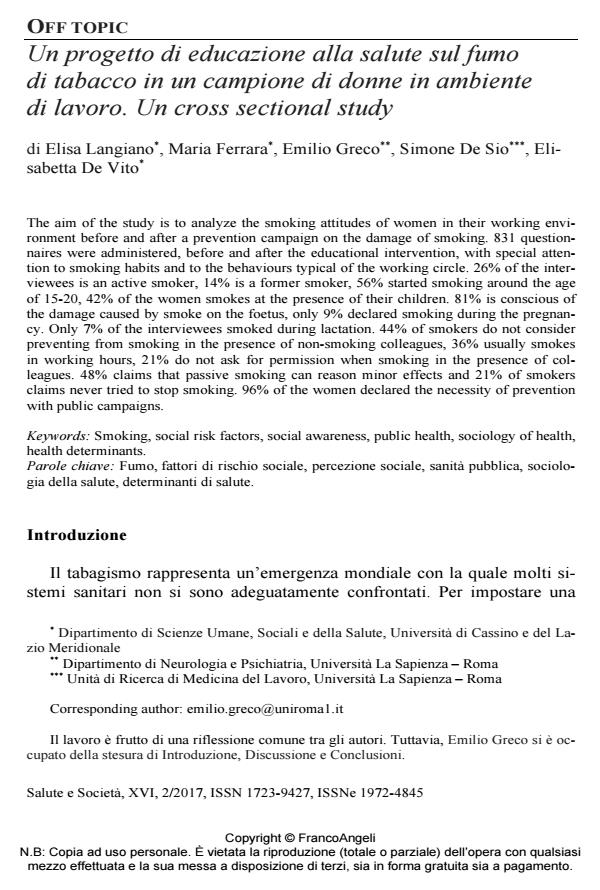Un progetto di educazione alla salute sul fumo di tabacco in un campione di donne in ambiente di lavoro. Un cross sectional study
Titolo Rivista SALUTE E SOCIETÀ
Autori/Curatori Elisa Langiano, Maria Ferrara, Emilio Greco, Simone De Sio, Elisabetta De Vito
Anno di pubblicazione 2017 Fascicolo 2017/2
Lingua Italiano Numero pagine 14 P. 135-148 Dimensione file 90 KB
DOI 10.3280/SES2017-002010
Il DOI è il codice a barre della proprietà intellettuale: per saperne di più
clicca qui
Qui sotto puoi vedere in anteprima la prima pagina di questo articolo.
Se questo articolo ti interessa, lo puoi acquistare (e scaricare in formato pdf) seguendo le facili indicazioni per acquistare il download credit. Acquista Download Credits per scaricare questo Articolo in formato PDF

FrancoAngeli è membro della Publishers International Linking Association, Inc (PILA)associazione indipendente e non profit per facilitare (attraverso i servizi tecnologici implementati da CrossRef.org) l’accesso degli studiosi ai contenuti digitali nelle pubblicazioni professionali e scientifiche
The aim of the study is to analyze the smoking attitudes of women in their working envi-ronment before and after a prevention campaign on the damage of smoking. 831 question-naires were administered, before and after the educational intervention, with special attention to smoking habits and to the behaviours typical of the working circle. 26% of the interviewees is an active smoker, 14% is a former smoker, 56% started smoking around the age of 15-20, 42% of the women smokes at the presence of their children. 81% is conscious of the damage caused by smoke on the foetus, only 9% declared smoking during the pregnancy. Only 7% of the interviewees smoked during lactation. 44% of smokers do not consider preventing from smoking in the presence of non-smoking colleagues, 36% usually smokes in working hours, 21% do not ask for permission when smoking in the presence of colleagues. 48% claims that passive smoking can reason minor effects and 21% of smokers claims never tried to stop smoking. 96% of the women declared the necessity of prevention with public campaigns.
Parole chiave:Fumo, fattori di rischio sociale, percezione sociale, sanità pubblica, sociologia della salute, determinanti di salute.
Elisa Langiano, Maria Ferrara, Emilio Greco, Simone De Sio, Elisabetta De Vito, Un progetto di educazione alla salute sul fumo di tabacco in un campione di donne in ambiente di lavoro. Un cross sectional study in "SALUTE E SOCIETÀ" 2/2017, pp 135-148, DOI: 10.3280/SES2017-002010